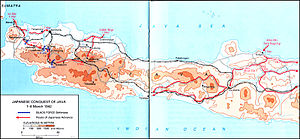This article has multiple issues. Please help improve it or discuss these issues on the talk page. (Learn how and when to remove these messages)
|
| Battle of Java | |||||||
|---|---|---|---|---|---|---|---|
| Part of World War II, Pacific War | |||||||
 Map depicting Allied defensive lines (in blue) and the movement of Japanese forces (red) in Java, 1–8 March 1942. | |||||||
| |||||||
| Belligerents | |||||||
|
|
| ||||||
| Commanders and leaders | |||||||
|
|
| ||||||
| Strength | |||||||
|
34,250 |
| ||||||
| Casualties and losses | |||||||
|
Netherlands: unknown Great Britain: unknown Australia: 36 killed 60 wounded 2736 captured United States: 825 killed 1,067 captured (US Army: 24 killed, 534 captured. US Navy: 801 killed, 369 captured. 165 prisoners later died in captivity.) | Unknown | ||||||
The Battle of Java (Invasion of Java, Operation J) was a battle of the Pacific theatre of World War II. It occurred on the island of Java from 28 February – 12 March 1942. It involved forces from the Empire of Japan, which invaded on 28 February 1942, and Allied personnel. Allied commanders signed a formal surrender at Japanese headquarters at Bandung on 12 March.
- ^ L, Klemen (1999–2000). "Lieutenant-General Hitoshi Imamura". Forgotten Campaign: The Dutch East Indies Campaign 1941–1942.